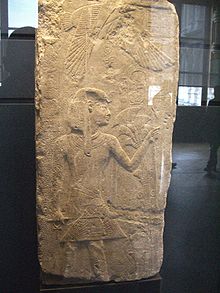- Menkauhor Kaiu
-
Menkauhor Kaiu 
18th dynasty stele depicting the 5th dynasty pharaoh Menkauhor Kaiu.Pharaoh of Egypt Reign 2421–2414 BC[1], 5th dynasty Predecessor Nyuserre Ini Successor Djedkare Isesi -
Prenomen: Men-kau-hor
Eternal are the Souls of Horus[2] -







-
Nomen: -





-
Horus name: -




-
Consort(s) Meresankh IV?
Khuit I?Children Djedkare Isesi (possibly cousin or brother) Menkauhor Kaiu (Menkaouhor, in Greek known as Menkeris), was a Pharaoh of the Fifth dynasty during the Old Kingdom. He was the successor of King Nyuserre Ini and was succeeded by Djedkare Isesi. Menkauhor's royal name or prenomen means "Eternal are the Souls of Horus".[2]
Contents
Family
Menkauhor may have been a son of Nyuserre. Reliefs from the mortuary temple of Khentkaus II may point to this proposed family relationship, but it is not a certainty.[3]
Queen Meresankh IV has been suggested as the consort for Menkauhor.[4] It is possible however that she was a wife to Djedkare Isesi instead. Queen Khuit I has also been suggested as a possible wife of Menkauhor, but this is not certain.[5]
It has been suggested that Menkauhor's successor Djedkare Isesi was his son.[3] Other possible children include the princes Raemka and Khaemtjenent, but it is also possible they are sons of Djedkare Isesi,[4] so they could be his grandsons instead.
Biography
The Turin King List assigns Menkauhor 8 years of rule. He was the last pharaoh to build a sun temple—called Akhet-Re. His pyramid was reported to have been found in 1842 by German archaeologist Karl Richard Lepsius at Saqqara. Lepsius called it number 29 or the "Headless Pyramid".[6] The pyramid was then lost under shifting sands until it was rediscovered in 2008.[7] The pyramid is believed to be his. This would validate contemporary fifth dynasty records which indicate Menkauhor's pyramid was located at either Dahshur or Saqqara. He is, in terms of present-day knowledge, the second most obscure 5th Dynasty ruler after the ephemeral Shepseskare — although a relief by an official named Tjutju depicts him adoring the pharaoh, one major quarry inscription at Wadi Maghara in the Sinai dated to his reign, a single seal bearing his name and a small alabaster statue prove his existence beyond doubt.[8]
Several Old Kingdom administrative records at Abusir indicate that Menkauhor finished his pyramid complex which was called Ntry-iswt-Mn-kw-hr while his funerary cult was still operational long after his death.[9]
References
- ^ Shaw, Ian, ed (2000). The Oxford History of Ancient Egypt. Oxford University Press. p. 480. ISBN 0-19-815034-2.
- ^ a b Clayton, Peter A. Chronicle of the Pharaohs: The Reign-by-Reign Record of the Rulers and Dynasties of Ancient Egypt. p.61. Thames & Hudson. 2006. ISBN 0-500-28628-0
- ^ a b M. Verner, The Pyramids, 1997
- ^ a b Dodson, Hilton, The Complete Royal Families of Ancient Egypt, 2004
- ^ W. Grajetzki, Ancient Egyptian Queens: a hieroglyphic dictionary, 2005
- ^ "Egypt uncovers 'missing' pyramid of a pharaoh", http://news.yahoo.com/s/ap/20080605/ap_on_re_mi_ea/egypt_missing_pyramid_4, Katarina Kratovac, AP, June 5, 2008
- ^ "Archeologists find 'missing pyramid' - CNN.com". http://www.cnn.com/2008/WORLD/africa/06/05/missing.pyramid.ap/index.html.[dead link]
- ^ Miroslav Verner, Archaeological Remarks on the 4th and 5th Dynasty Chronology, Archiv Orientální, Volume 69: 2001, p.405
- ^ Verner, p.405
External links
Categories:- Pharaohs of the Fifth dynasty of Egypt
-
Wikimedia Foundation. 2010.
